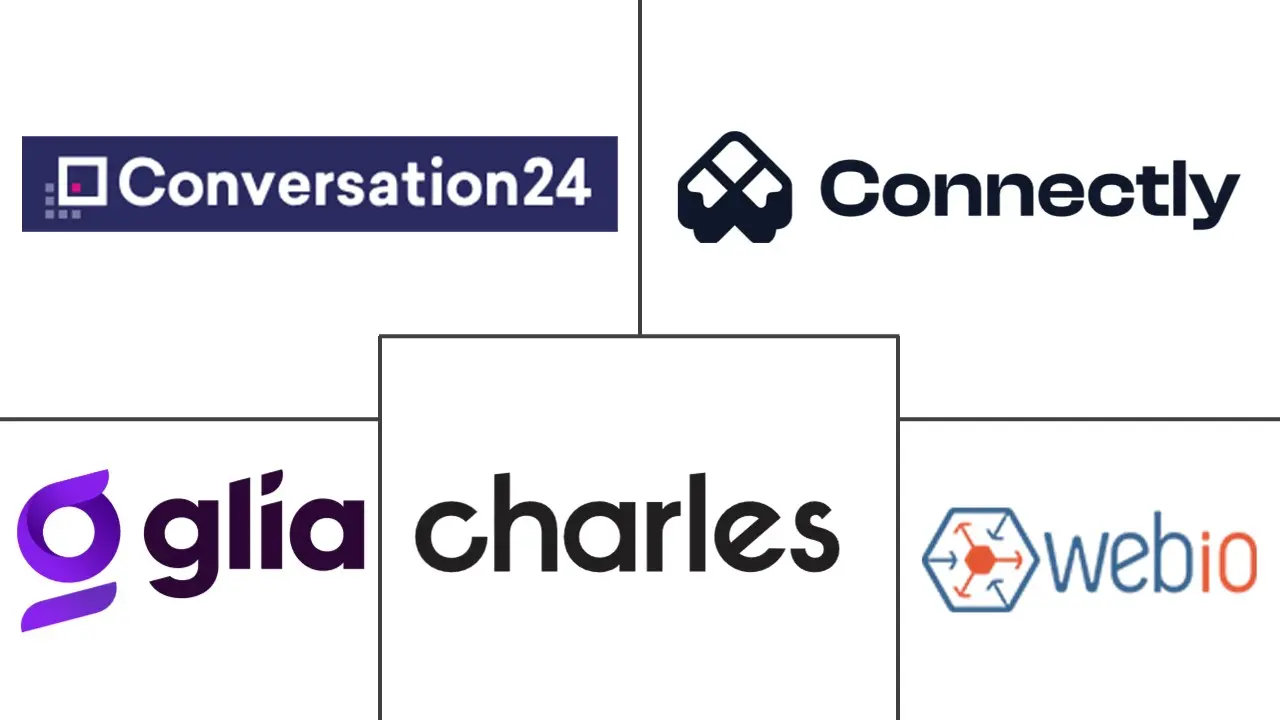Conversational Commerce Market Size and Share

Conversational Commerce Market Analysis by Mordor Intelligence
The Conversational Commerce Market size is estimated at USD 11.26 billion in 2025, and is expected to reach USD 20.28 billion by 2030, at a CAGR of 12.47% during the forecast period (2025-2030).
Rising consumer preference for in-chat transactions, expanding AI capabilities, and the unification of messaging standards are reshaping purchase journeys. Businesses now embed payments, product discovery, and support inside a single conversational thread, eliminating redirects that previously hampered conversion. High engagement rates have persuaded retailers, banks, and healthcare providers to prioritise conversational channels in their digital roadmaps. At the same time, technology suppliers are consolidating to control end-to-end ecosystems, a trend that amplifies platform power while intensifying competition for differentiated customer experiences.[1]Erik J. Martin, “Get Ready for High-Tech Texting,” Destination CRM, destinationcrm.com
Key Report Takeaways
- By type, chatbots commanded 64% of the conversational commerce market share in 2024, whereas intelligent virtual assistants are advancing at a 15.8% CAGR to 2030.
- By component, software and solutions brought in 74% revenue in 2024, while the services segment is expanding at a 14.9% CAGR through 2030.
- By deployment mode, the cloud model held 78% of the conversational commerce market size in 2024 and is projected to post a 13.6% CAGR over 2025-2030.
- By organisation size, large enterprises captured 66% market share in 2024; small and medium enterprises are set to grow at 17.2% CAGR to 2030.
- By end-user industry, retail and e-commerce led with 41% share in 2024, yet healthcare is poised for the fastest 19.8% CAGR during the period.
- By geography, North America accounted for 34% of global revenue in 2024, whilst Asia Pacific is forecast to record a 17% CAGR through 2030.
Global Conversational Commerce Market Trends and Insights
Drivers Impact Analysis
| Driver | (~) % Impact on CAGR Forecast | Geographic Relevance | Impact Timeline |
|---|---|---|---|
| Rapid roll-out of WhatsApp Business in India & Brazil enabling in-chat payments | +3.2% | India, Brazil, with spillover to Southeast Asia | Short term (≤ 2 years) |
| Voice-enabled smart-speaker check-out penetration across US households | +2.1% | North America, Western Europe | Medium term (2-4 years) |
| Mandatory RCS roll-outs by European MNOs unlocking rich messaging commerce | +2.8% | Europe, with global implications | Medium term (2-4 years) |
| Live-video social commerce in China catalysing transactable chat sessions | +2.5% | China, with spillover to Southeast Asia | Short term (≤ 2 years) |
| Availability of foundation-model APIs lowering SME chatbot build cost drives the market | +1.9% | Global, with emphasis on developed markets | Medium term (2-4 years) |
| Bank-grade KYC plug-ins for messaging apps driving regulated BFSI use cases in North America | +1.7% | North America, Europe | Long term (≥ 4 years) |
| Source: Mordor Intelligence | |||
Rapid WhatsApp Business Expansion Transforms Emerging Markets
In-chat payments embedded in WhatsApp are bringing millions of small merchants online almost overnight. Eliminating gateways speeds check-out and lifts conversion, especially in cash-dominant economies with limited card circulation. Payment interoperability inside the app also gives consumers a consistent experience across merchants, underscoring why large enterprises in India and Brazil plan widespread API adoption. The model is replicable in other high-smartphone, low-card regions, positioning WhatsApp as an express lane to digital commerce for micro and small sellers.
Voice Commerce Redefines Ambient Shopping Experiences
Smart speakers convert passive listening moments into purchase opportunities by allowing users to re-order staples or secure flash deals using short verbal prompts. Households that adopt voice assistants typically see weekly spending rise because frictionless re-ordering shortens decision windows. Brands gain incremental share of wallet by surfacing context-relevant offers during routine interactions such as cooking or commuting, creating new revenue touch points outside traditional web or app paths.
RCS Adoption Creates Universal Rich Business Messaging Channel
Integration of Rich Communication Services in iOS18 harmonises the previously fragmented Android and iPhone messaging bases. Enterprises can now push interactive carousels, payment buttons, and verified sender information to nearly every smartphone user without asking customers to install separate apps. Higher fidelity content inside the native inbox boosts engagement and accelerates purchase completion, bringing marketing efficiency gains that exceed those of legacy SMS.
Live Video Commerce Creates Immersive Social Shopping Experiences
China has popularised live-stream sessions where hosts showcase products, address questions, and close sales in real time. Embedding a chat window beside the video fosters a community atmosphere that reinforces trust and triggers impulsive buys. While the format is mature in mainland China, regional spillover across Southeast Asia is gaining pace as social platforms replicate the template. Brands use live sessions to compress awareness, evaluation, and transaction into one interactive event, raising conversion far above standard e-commerce pages.
Restraints Impact Analysis
| Restraint | (~) % Impact on CAGR Forecast | Geographic Relevance | Impact Timeline |
|---|---|---|---|
| EU Digital Markets Act limits platform self-preferencing of commerce flows | -1.8% | European Union, with global strategic implications | Medium term (2-4 years) |
| Apple iOS privacy updates reduce 3rd-party conversion tracking in messages | -1.5% | Global, with emphasis on developed markets | Short term (≤ 2 years) |
| Fragmented payment standards in Africa depress completion rates | -0.9% | Africa, with implications for emerging markets | Long term (≥ 4 years) |
| NLP accuracy gaps in low-resource Asian languages hinders the market | -1.2% | Southeast Asia, South Asia | Medium term (2-4 years) |
| Source: Mordor Intelligence | |||
Regulatory Constraints Reshape Platform Economics
The Digital Markets Act compels designated gatekeepers to open their ecosystems and treat rival services on equal footing. Messaging platforms must now allow external payment and shopping widgets, diluting their control over transaction flows. Compliance investment diverts funds from product innovation and slows feature roll-outs, adding a structural drag to European revenue growth.
Privacy Changes Disrupt Attribution Models
Apple’s stricter consent rules cut access to device identifiers that marketers relied on for cross-channel attribution. Measurement gaps make it harder to prove return on conversational campaigns, so budgets migrate toward channels with native first-party analytics. Platform owners able to deliver closed-loop reporting within their environments gain an advantage, reinforcing consolidation trends even as overall tracking complexity rises.
Segment Analysis
By Type: Intelligent Virtual Assistants Gain Momentum
Chatbots delivered 64% of conversational commerce market share in 2024 by handling routine queries such as order status and store hours. Their deterministic scripts suit predictable tasks, keeping deployment cost low. However, intelligent virtual assistants are surging at a 15.8% CAGR, fuelled by transformer-based language models that sustain multi-turn dialogues and personalise recommendations. The shift positions IVAs for complex pre-purchase advisory and post-sale problem resolution, raising customer satisfaction and average order value.
North American enterprises pioneer IVA patents and pilot projects, resulting in earlier productivity gains. Retailers embed assistants across web, voice, and social channels to unify brand tone and context. As models become cheaper to fine-tune, smaller firms will add IVA layers atop existing chatbots, creating a continuum from FAQ to consultative selling within the same interface.
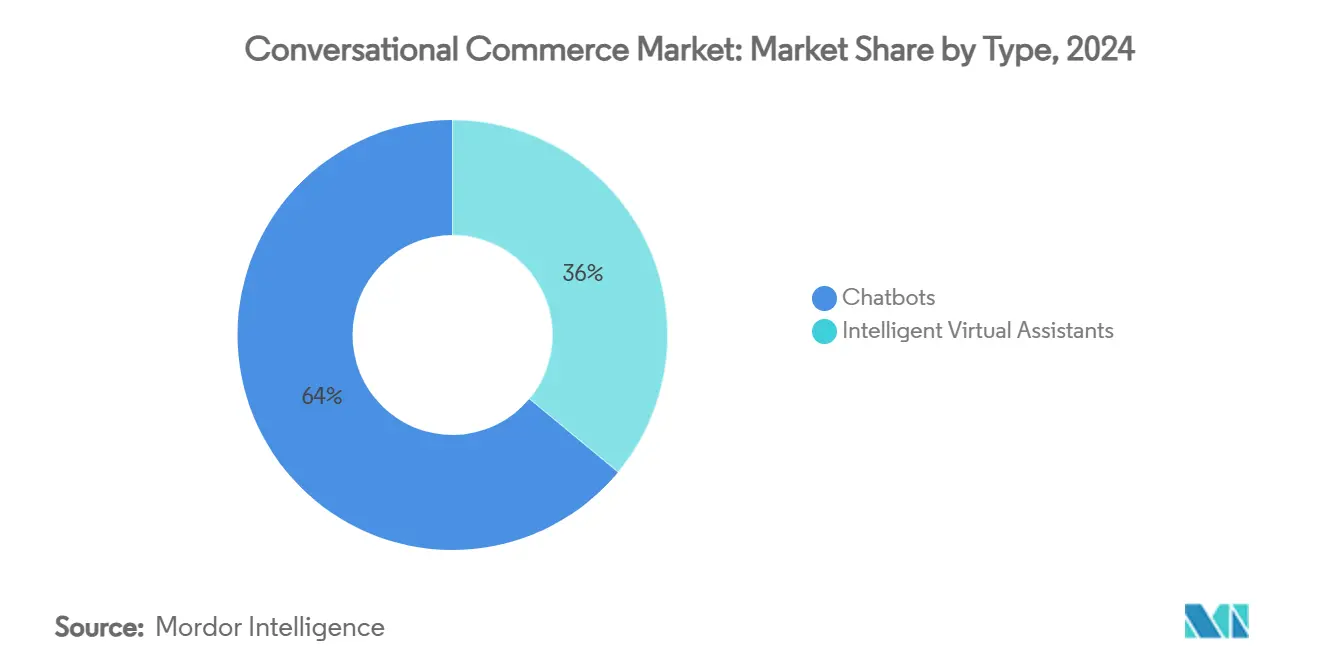
By Component: Services Capture a Larger Growth Slice
Software licences still represent 74% of 2024 revenue, reflecting widespread procurement of bot builders, NLP engines, and omni-channel orchestration suites. Yet rising implementation complexity is pushing services to expand at a 14.9% CAGR. Enterprises increasingly pay for strategic road-mapping, data integration, custom intent training, and performance optimisation.
The Shopwise proof-point shows that expert configuration can lift response accuracy to 95% and cut product discovery time by 71%, illustrating why enterprises view professional services as an insurance policy for ROI. Managed services also address talent shortages in conversational AI, enabling continuous improvement without overstretching in-house teams.
By Deployment Mode: Cloud Underpins Scalability Demands
Public cloud held 78% of the conversational commerce market size in 2024 because scale-out infrastructure is essential for bursty message loads and compute-heavy language models. Providers bundle edge routing, security, and compliance certifications, allowing brands to concentrate on conversation design rather than server tuning. Cloud platforms also deliver iterative AI enhancements as managed features, shortening innovation cycles.
On-premises deployments persist in highly regulated verticals where data locality is mandatory. Financial institutions opt for hybrid models that keep personally identifiable data behind firewalls while consuming cloud-based NLP through secure APIs. Nevertheless, the elasticity and lower total cost of ownership of cloud will continue to outweigh the control benefits of in-house stacks for most use cases.
By Organisation Size: SMEs Narrow the Capability Gap
Large enterprises still account for 66% revenue because they can stitch conversational interfaces into extensive CRM and ERP systems. They also enjoy favourable volume discounts from cloud and messaging providers. However, SMEs are poised for 17.2% CAGR growth as foundation model APIs reduce technical barriers. Low-code bot builders with pre-trained industry intents allow resource-constrained firms to launch pilots within weeks instead of months.
Competitive pressure motivates SMEs to match the instant support that consumers now consider hygiene. Early adopters report cost-effective lead generation and higher customer loyalty, proving the business case even for modest transaction volumes. As pricing becomes usage-based, SMEs can scale investment in line with demand, mitigating financial risk.
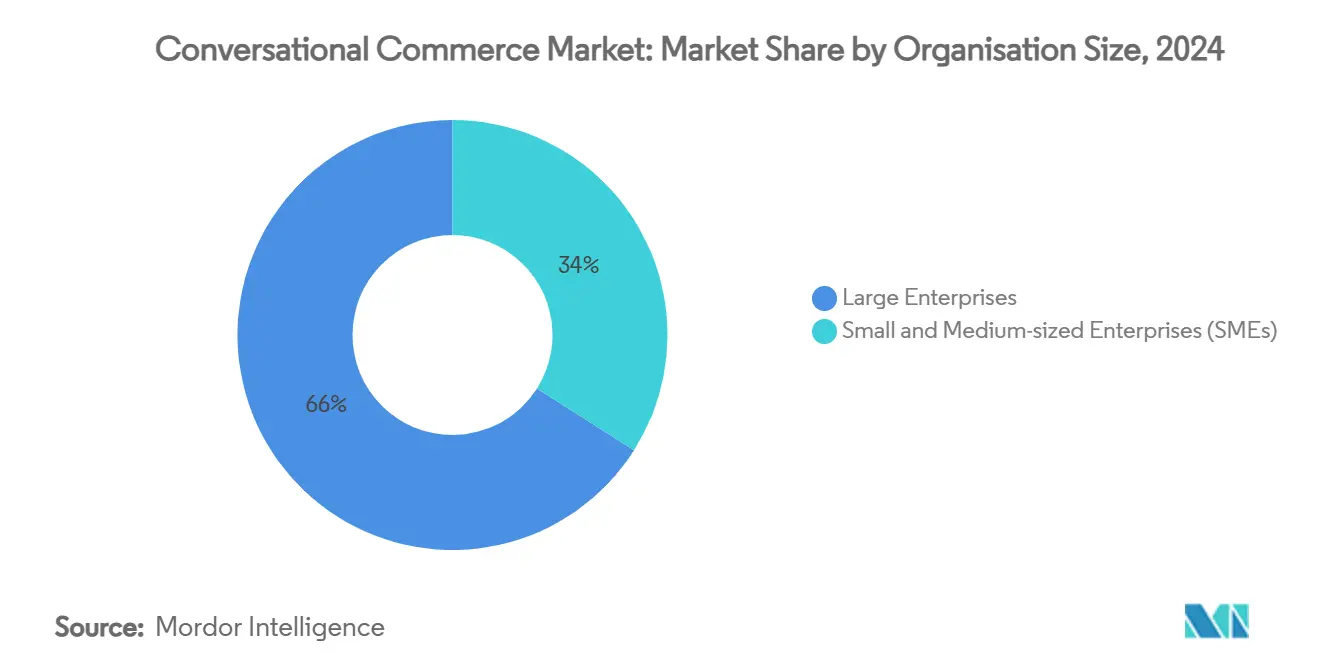
By End-user Industry: Healthcare Emerges as Growth Leader
Retail and e-commerce dominated with 41% share in 2024 due to direct revenue linkage between conversation and sale. Personalised recommendations and abandoned-cart reminders remain staple features. Yet healthcare providers are forecast to grow at 19.8% CAGR, deploying conversational interfaces for appointment scheduling, symptom triage, prescription refills, and post-discharge follow-ups.
The sector’s growth is enabled by secure messaging frameworks that comply with health data regulations, combined with patient appetite for remote interactions. Conversational solutions ease administrative bottlenecks and expand access to care, aligning with broader digital health objectives. Other verticals such as banking and telecom continue to expand their installed bases, though at more moderate rates compared with the two headline industries.
Geography Analysis
North America generated 34% of global revenue in 2024 thanks to high card penetration, advanced cloud adoption, and a vibrant AI innovation ecosystem. Banks integrate passwordless authentication and behavioural biometrics to secure conversational purchases, driving trust in the channel. Joint ventures such as the Perplexity-PayPal partnership illustrate the region’s capacity to commercialise research rapidly, reinforcing its leadership position.
Asia Pacific is the demand powerhouse, forecast to achieve 17% CAGR through 2030. China’s mastery of live-stream commerce has set a precedent for immersive chat shopping. India’s merchants flock to WhatsApp Business as a turnkey storefront, embracing in-chat payments that accommodate diverse local wallets and real-time payment rails. Southeast Asia benefits from emergent language models tailored to Thai, Vietnamese, and Bahasa, which raise response accuracy and foster adoption in multilingual markets.
Europe’s trajectory is shaped by regulatory forces that temper platform dominance while promoting richer messaging standards. Mandatory RCS support from mobile operators unlocks app-like experiences inside the inbox, fuelling consumer uptake. Voice commerce adoption is highest in the United Kingdom, where smart-speaker penetration exceeds regional averages. Germany leverages conversational interfaces for B2B service management, and Spain uses chatbots to streamline tourism bookings. Fragmented payment frameworks continue to restrict completion rates in parts of Africa, yet local fintech innovation and API harmonisation efforts aim to ease barriers over the long term.
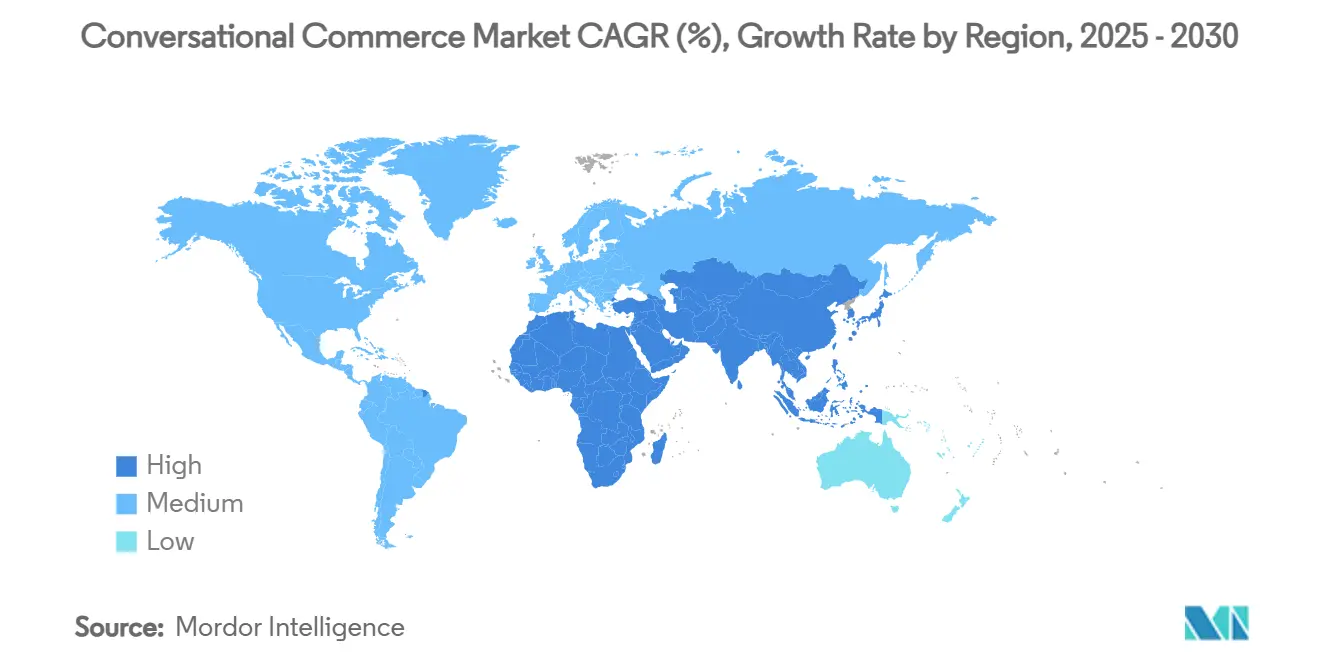
Competitive Landscape
The ecosystem is moderately concentrated around a handful of platform owners that command both messaging reach and AI infrastructure. Their influence intensified in 2024–2025 through targeted acquisitions that bundled orchestration, language models, and payment rails into unified suites. Salesforce’s launch of Agentforce embodies this trend, bringing generative intelligence directly into the customer service console to shorten resolution time and uplift cross-sell success.
The competitive landscape is characterized by strategic consolidation among major technology players seeking to build end-to-end conversational commerce ecosystems. Apple's integration of RCS in iOS 18 represents a pivotal development, breaking down the messaging barrier between iOS and Android users and creating a unified channel for business messaging that reaches nearly all smartphone users globally.[2]Sinch AB, “RCS in iOS 18: Apple’s Updates and What’s Next for iPhone Support,” sinch.com This interoperability, combined with the fivefold increase in RCS adoption in 2024, signals a fundamental restructuring of the messaging ecosystem that will accelerate conversational commerce adoption across previously fragmented platforms [3]Infobip, “Infobip Research Reveals Fivefold Adoption of RCS in 2024,” infobip.com
Specialist vendors focus on vertical depth, for example by embedding drug formulary logic into pharmacy chatbots or offering compliance toolkits for regulated industries. Start-ups building agent-friendly storefronts extend brand presence into messaging apps without heavy engineering, enabling merchants to deploy catalogue, cart, and payment flows via a single link. These niche innovators create differentiation based on domain expertise rather than raw NLP power.
Strategic partnerships are a vital route to market, illustrated by Microsoft’s alliances with retailers that bundle Azure cognitive services with cloud migration projects. Larger firms co-create proof-of-concepts to showcase rapid ROI, while smaller providers white-label their engines to telecom carriers hungry for value-added services. Competitive advantage hinges on maintaining conversation context across voice, text, and video channels, a capability that demands real-time data synchronisation and advanced session management.
Conversational Commerce Industry Leaders
-
Glia Technologies, Inc.,
-
Connectly Inc.
-
Charles GmbH
-
Conversation24 Ltd.
-
Webio
- *Disclaimer: Major Players sorted in no particular order
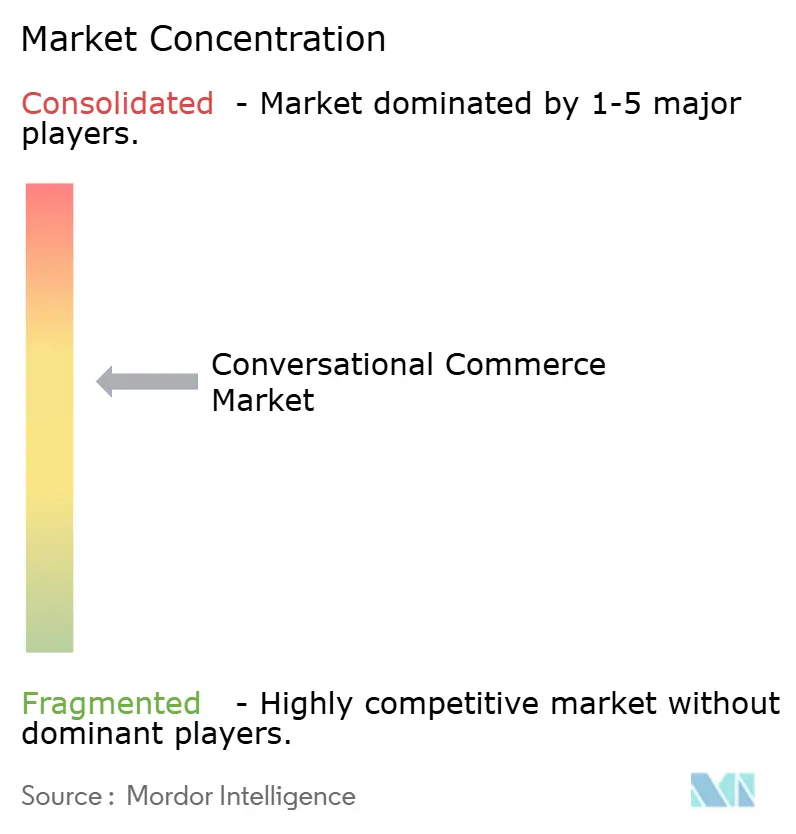
Recent Industry Developments
- May 2025: Glance introduced Glance AI, a discovery-led commerce feed that surfaces tailored products on locked phone screens, turning idle moments into shopping windows. Concurrently, ShopAi’s GREGG voice bot targeted physical stores to guide customers toward relevant aisles, merging digital intelligence with in-store navigation.
- May 2025: Perplexity partnered with PayPal to merge natural-language search and one-click checkout, reducing steps from discovery to purchase. PayPal benefits from incremental transaction volume, while Perplexity gains payment credentials that anchor users within its interface.
- March 2025: Infobip disclosed a fivefold spike in enterprise RCS traffic after Apple enabled the protocol, highlighting how cross-ecosystem interoperability accelerates adoption. By offering pre-built templates, Infobip lowered entry barriers for marketers seeking measurable gains over SMS.
- January 2025: Prodege rolled out a conversational AI layer that plugs into its rewards platform, aiming to lift member engagement by delivering personalised survey invitations inside chat threads. The strategy positions Prodege to monetise higher response rates and upsell advertisers through richer targeting.
Global Conversational Commerce Market Report Scope
The Conversational Commerce Market is defined based on the revenues generated from the software and services that are being used in various end-user industries across the globe. The study tracks the key market parameters, underlying growth influencers, and major vendors operating in the industry, which supports the market estimations and growth rates over the forecast period.
The conversational commerce market is segmented by type (chatbots, intelligent virtual assistants), by component (software, services), by deployment model (cloud, on-premises), by organization size (SMEs, large enterprises), by end-user industries (BFSI, IT and telecom, healthcare, travel and hospitality, retail and ecommerce, and others), by geography (North America, Europe, Asia, Australia and New Zealand, Latin America, Middle East and Africa). The market sizes and forecasts are provided in terms of value (USD) for all the above segments.
| Chatbots |
| Intelligent Virtual Assistants |
| Software / Solutions |
| Services |
| Cloud |
| On-Premises |
| Small and Medium-sized Enterprises (SMEs) |
| Large Enterprises |
| Banking, Financial Services and Insurance (BFSI) |
| Information Technology and Telecom |
| Healthcare |
| Travel and Hospitality |
| Retail and E-commerce |
| Other End-user Industries |
| North America | United States |
| Canada | |
| Mexico | |
| Europe | United Kingdom |
| Germany | |
| France | |
| Spain | |
| Rest of Europe | |
| Asia-Pacific | China |
| India | |
| Japan | |
| South Korea | |
| Rest of Asia-Pacific | |
| South America | Brazil |
| Argentina | |
| Rest of South America | |
| Middle East | Saudi Arabia |
| United Arab Emiartes | |
| Rest of Middle East | |
| Africa | South Africa |
| Nigeria | |
| Rest of Africa |
| By Type | Chatbots | |
| Intelligent Virtual Assistants | ||
| By Component | Software / Solutions | |
| Services | ||
| By Deployment Mode | Cloud | |
| On-Premises | ||
| By Organisation Size | Small and Medium-sized Enterprises (SMEs) | |
| Large Enterprises | ||
| By End-user Industry | Banking, Financial Services and Insurance (BFSI) | |
| Information Technology and Telecom | ||
| Healthcare | ||
| Travel and Hospitality | ||
| Retail and E-commerce | ||
| Other End-user Industries | ||
| By Geography | North America | United States |
| Canada | ||
| Mexico | ||
| Europe | United Kingdom | |
| Germany | ||
| France | ||
| Spain | ||
| Rest of Europe | ||
| Asia-Pacific | China | |
| India | ||
| Japan | ||
| South Korea | ||
| Rest of Asia-Pacific | ||
| South America | Brazil | |
| Argentina | ||
| Rest of South America | ||
| Middle East | Saudi Arabia | |
| United Arab Emiartes | ||
| Rest of Middle East | ||
| Africa | South Africa | |
| Nigeria | ||
| Rest of Africa | ||
Key Questions Answered in the Report
What is the projected value of the conversational commerce market in 2030?
The conversational commerce market size is forecast to reach USD 20.28 billion by 2030 based on a 12.47% CAGR.
Which segment is expected to expand fastest during 2025-2030?
Healthcare leads with a 19.8% CAGR as providers adopt chatbots and virtual assistants for patient engagement and operational efficiency.
Why is Asia Pacific the fastest-growing region?
Smartphone penetration, super-app dominance, and local language AI models drive a 17% regional CAGR, surpassing growth elsewhere.
How will RCS affect business messaging strategies?
Universal support for RCS enables interactive content and in-thread payments on most smartphones, improving conversion and reducing reliance on standalone apps.
What role do small and medium enterprises play in market growth?
SMEs are positioned for 17.2% CAGR because low-code tools and foundation model APIs lower cost barriers, allowing them to match enterprise-grade experiences.
Page last updated on:
